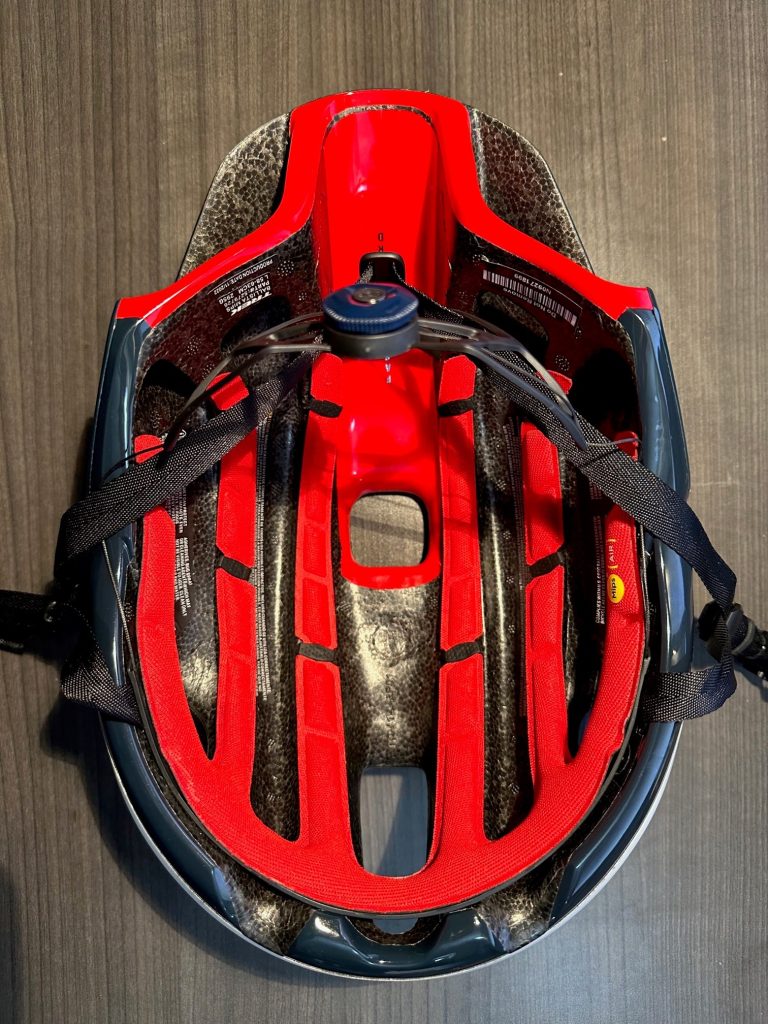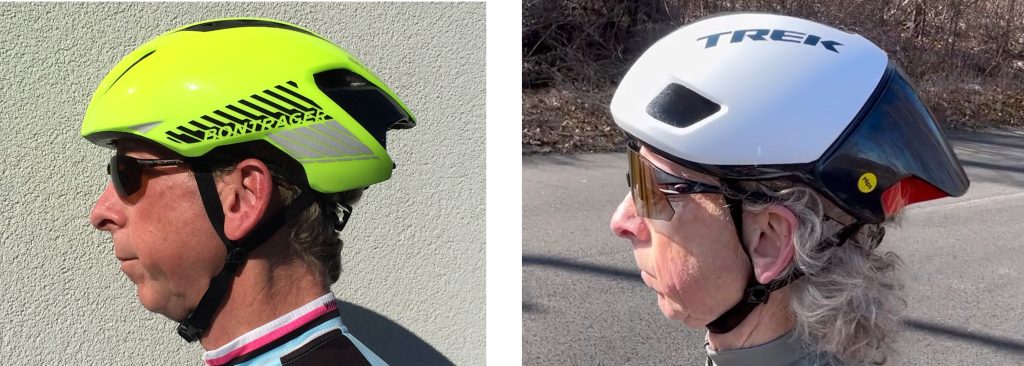TREK BALLISTA MIPS – LOOKS ARE DECEIVING

With each new generation of aero road helmets, brands have significantly changed their designs while merely tweaking the model name suffixes – Specialized Evade 3, Oakley ARO5 Race, Giro Eclipse Spherical.
The Ballista Mips has changed its brand name from Bontrager to Trek – same company, new brand strategy – rather than its model suffix
More importantly, the Trek Ballista Mips looks more like an aero helmet than it ever has, yet its latest design makes it feel more like one of the lightest and most comfortable standard-shaped road helmets we’ve ever tested.
INTEGRAL MIPS, NOT AN OVERLAY
While several alternatives to the original Mips have been introduced and score well in safety tests (e.g. HG11, Wavecel, Spherical), many helmet brands continue to license the technology and consumers remain willing to pay the premium for a helmet with the Mips sticker.
The key to any Mips helmet’s fit, comfort, and safety is how well it integrates the Mips system into the helmet. In the rush to show consumers that they were now on the Mips bandwagon, many of the first-generation Mips aero road helmets felt and looked like they had just slapped the apparatus into their existing helmet designs. They seemed like clumsy and often ill-fitting afterthoughts.
The Mips system inside the Trek Ballista Mips helmet looks and feels integral to it. Four front-to-back center strip pads and one that crosses your forehead and extends out to your temples attach to the helmet shell with two small velcro tabs on each strip, allowing all of the unattached area to move freely.
It’s all barely visible and doesn’t feel like an added helmet component.
A SECURE AND COMFORTABLE FIT
My head fits easily in the Ballista. The rear Boa dial provides simple and secure micro tensioning to adjust to my head’s shape. Instead of using a wire or strap as other helmets do, the Trek mechanism has a comfortable yet sturdy thread coming out of the dial that connects at the temples to a plastic piece on which the forehead pad rests.
The thread also runs through the cradling frame at the rear of your head in four places. This makes the pliable plastic material in that frame snuggly conform to the shape of the back of my head.
Trek also uses a somewhat novel though simple approach to adjust the rear height of the Ballista. Instead of a tab that slides up and down in a channel to one of typically five stops to set your height, you insert the Ballista’s tab into one of three fixed slots at different heights. Since I didn’t read the instructions (kudos to you if you do), this took a little time to figure out.
But once I found the right slot for my preferred helmet height, it was done. I didn’t need to bother with readjusting the helmet height when I put it on (e.g. Kask) or worry about it self-adjusting as I tightened or loosened the circumference strap (Lazer).
The Trek Ballista Mips uses locking clips to hold the down straps in place below your ears. The stiffness of the straps themselves is somewhere in the middle of the range of those I’ve experienced on different helmets. While that’s good in keeping the helmet in position, I’ve had to add a twist tie below the clips to get the straps to lay together.
The left and right straps connect with a standard push-in/out clip that sits directly below my chin. Beyond the clip, there’s also a lot more strap length than I’ll ever need. I’d want to cut off the extra if I wore this helmet beyond my test period.
The combination of adjustments gives me a secure, comfortable fit that doesn’t move around once I’ve dialed it in. I’ve also found that I don’t need to loosen or readjust it much or at all to take off or put on the helmet, depending on how thick or matted down my hair is on a given day.
My intermediate oval head shape, slightly more oval than round, suits the Trek Ballista head shape. It’s also relatively quiet on a fast ride, indicating a good fit and well-engineered design. The quiet also adds to the comfort.
AS COOL AS A STANDARD ROAD HELMET
Speaking of comfort, let me come back to one-half of what makes this Ballista different than its predecessor and shows just how far the aero road helmet category has come.
Air flows freely through the Ballista. My head never gets hot, no matter the temperature or ride intensity. The helmet has a large front center vent and smaller ones on either side that easily dock the various sunglasses of different sizes that I tried. These vents are similar in position and size to the previous Ballista and the Kask, Scott, Oakley, and Specialized aero road helmets and less than the POC.
The combination of a large intake vent just in front of the crown of my head and the wide open rear of the helmet that exhausts the air make the Trek Ballista unique and probably add to the cooling effect or at least the sense of riding with good airflow around your head. It’s almost as if I’m driving my old, before-kids ragtop convertible with the top up, but the side windows rolled down and the rear window removed. Then cut a good-sized hole in the canvas top, or just enlarge one of the ones that are already there, just above the front seats.
You get lots of air flowing through but little wind noise and some protection from the elements above.
The ample padding inside isn’t too stiff or spongy, wraps front to back and fully across my forehead, and doesn’t accumulate sweat.
Additionally, the Trek Ballista remains the lightest of the aero road helmets we weighed. At 289 grams for the Large size, it also weighed in on my scale lighter than the same size and latest, top-of-its-road-line, standard-shaped Trek Velocis helmet introduced at the same time as the Ballista.
LEANING INTO THE AERO LOOK
If anything, Trek seems to have leaned into the aero look of its aero road helmet. Previous Ballistas have always looked more like a straight-up aero helmet than a standard road one, but this latest model really seems to accentuate its rear beak-like tail.
At the same time, an indent across the outside shell just beyond the upper crown vent seems to separate the tail from the rest of the helmet visually. While I guess it’s there to trip the outside airflow so that it re-attaches to the tail, it tricks the eye into looking like some kind of hybrid aero and road helmet (or an aero road helmet) rather than a pure aero one.
In the glossy white/black color combo I tested, this works pretty well, or at least better than the one-tone white, matte black, and matte purple options it also comes in. But alongside other aero road and standard road helmets, the Ballista look isn’t probably fooling anyone.
Yet, as aero road helmets have become more accepted as the choice of regular enthusiasts, they are no longer seen as one worn by a time trial rider who showed up for a group ride with the wrong lid on. There’s no, or perhaps less shame wearing an aero road helmet these days for those of us looking to get 5 watts or so of marginal gains from our helmet choice.
Oh yeah, that describes me. The recent opening day event I attended by 100 or so of the riders in my local club made clear that I’m not alone.
If you’re one of us, the Trek Ballista is a well-fitting, proud-to-be aero road helmet option that looks the part but is as comfortable and cool as a standard one. At US$300/£230/€300, you can order it using these links to Trek and Sigma Sports.
In The Know Cycling is ad-free, subscription-free, and reader-supported. If you want to help keep it rolling without any added cost to you, buy your gear and kit after clicking the store links on the site. When you do, we may earn an affiliate commission that will help me cover the expenses to create and publish our independent, comprehensive, and comparative reviews. Thank you, Steve. Learn more.
You can compare this helmet to competitively performing models in my review of the Best Aero Helmet for Road Cyclists.


Thanks for another great review, Steve! I was just looking at a Bontrager Velocis MIPS for gravel riding. How do you rate these two against each other? Any helmet protection concerns re: the large front opening on the Ballista? Any thoughts re: the Trek Wavecel helmets? Looks like it’s going to be hot and heavy.
J, We’re about halfway through the Velocis testing now and should have a complete review out in June. It has the same fit, fitments, and comfort as the Ballista. I have ridden it on gravel and my only complaint is that it doesn’t securely dock my sunglasses. I tend to take them off on dark, wooded sections but if you always keep yours on, that won’t be an issue. Steve
awesome, thanks for your quick reply! I thought you’d already tested that Velocis MIPS helmet, but maybe you’re testing a newer version now?
Yes, a new Velocis was introduced at the same time as the new Ballista. You can see and order it here.